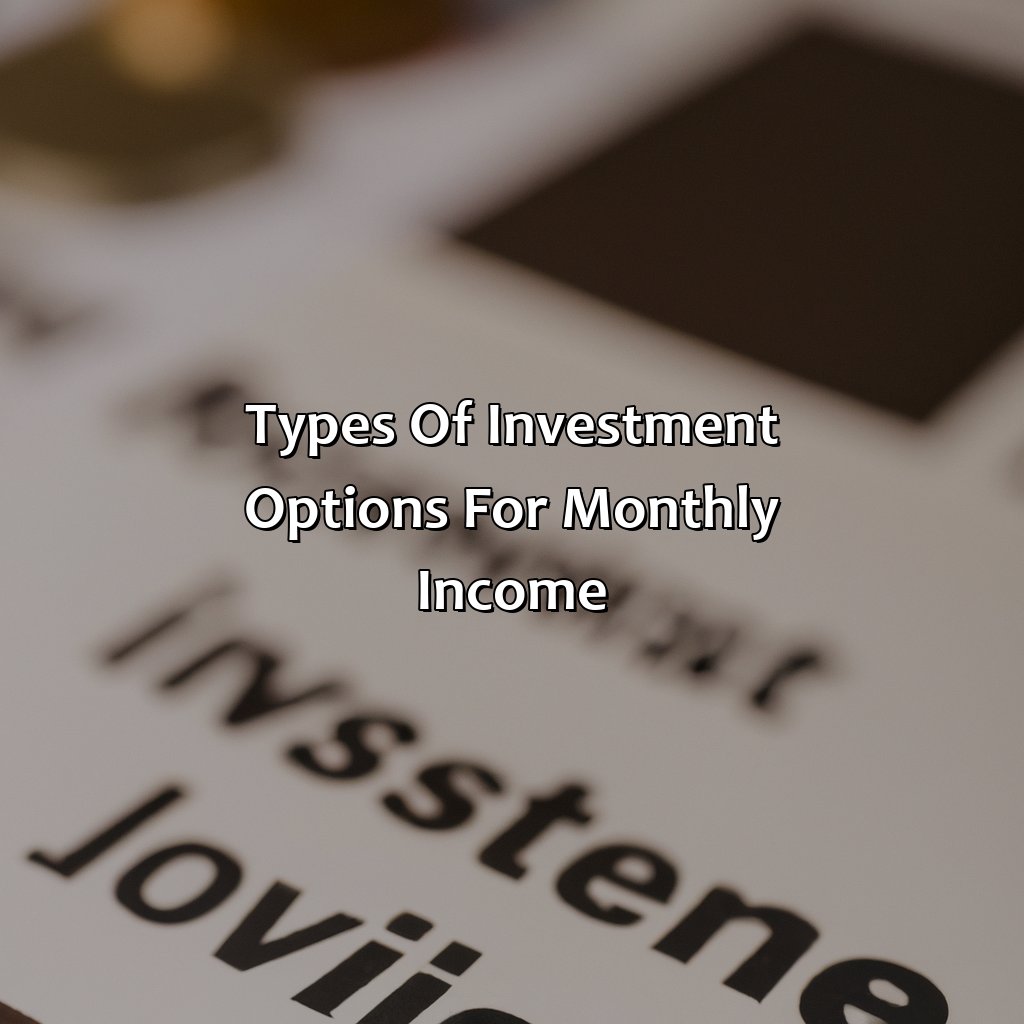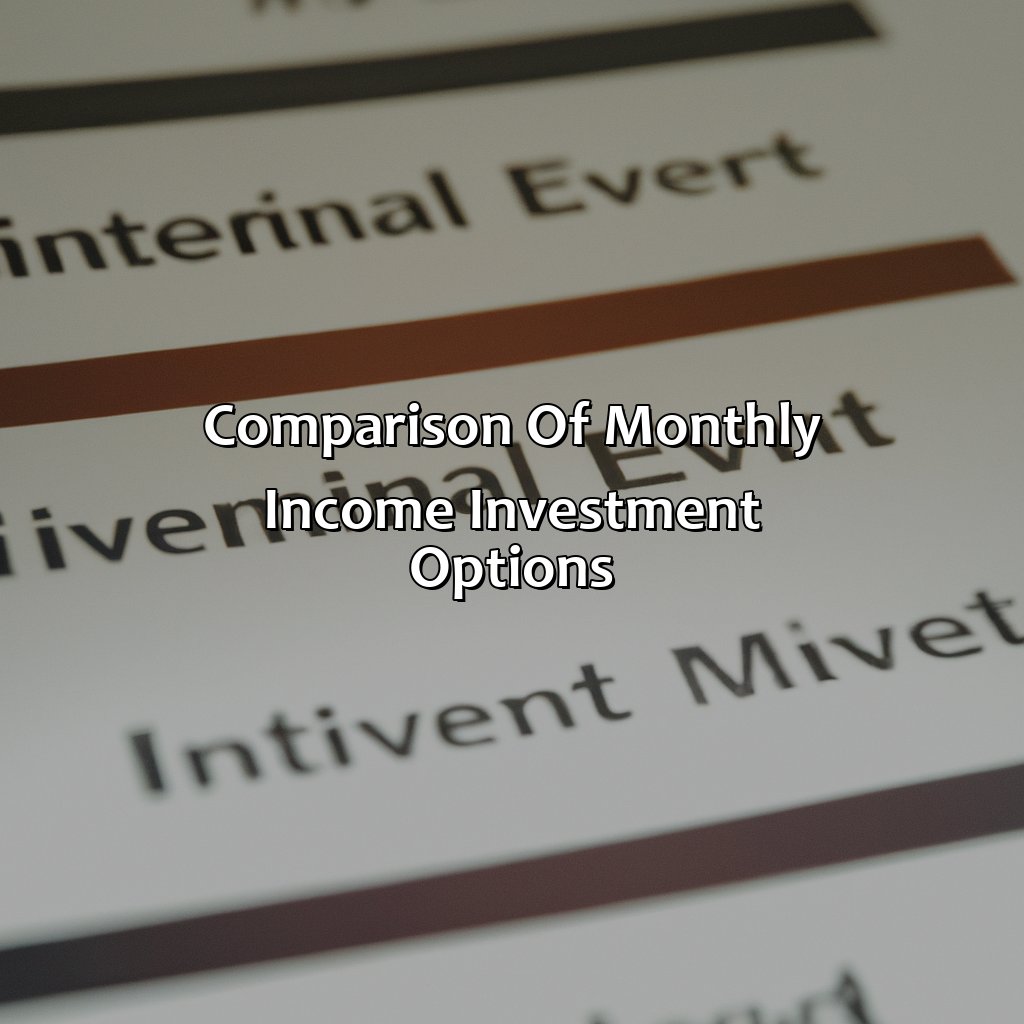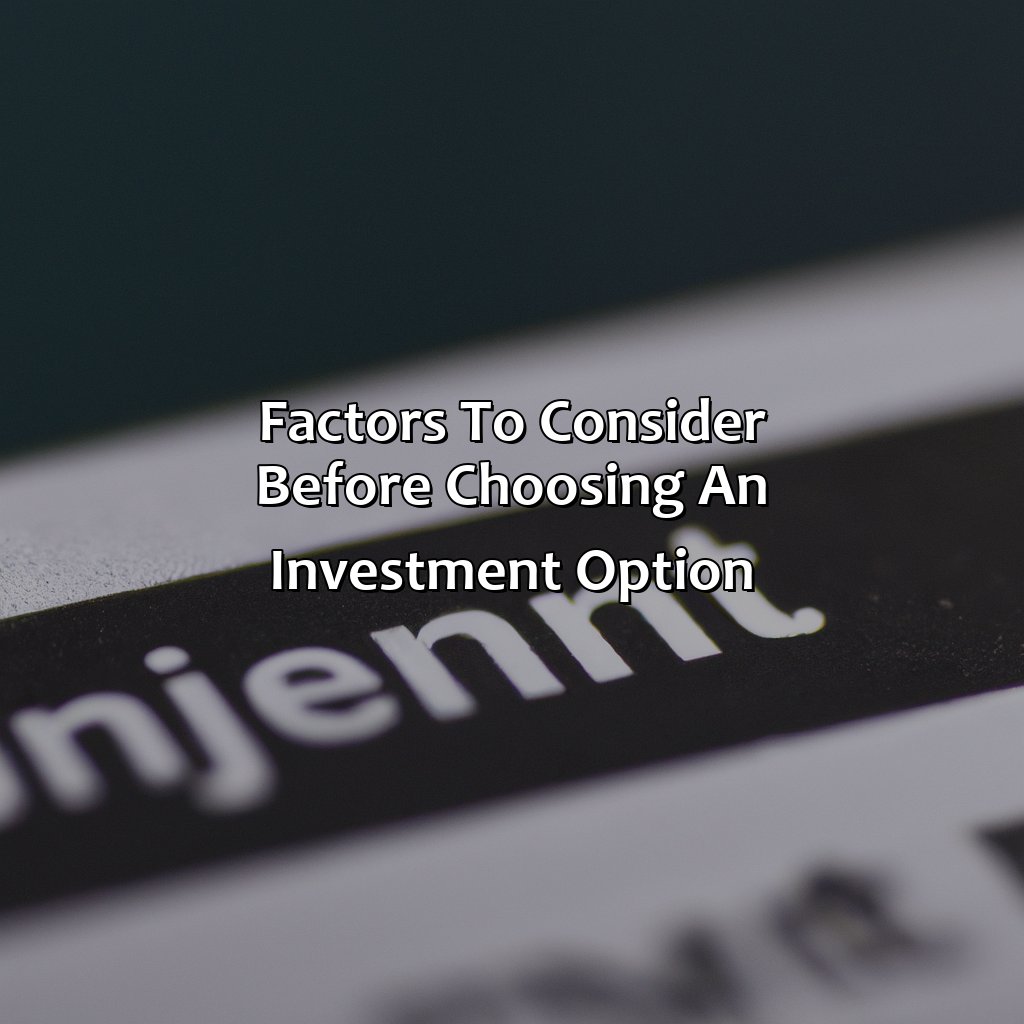What Is The Best Investment For Monthly Income?
Key Takeaway:
- Real Estate Investment Trusts (REITs) can provide reliable monthly income through dividends and the potential for long-term growth. However, they can be impacted by changes in the real estate market and have a higher risk level compared to other investment options.
- Dividend stocks can provide a steady stream of income through regular dividend payouts. They may have lower risk levels compared to REITs, but the returns may not be as high in the long run. It’s important to carefully research and choose well-established and reliable companies with a history of consistent dividend payouts.
- High Yield Savings Accounts are a low-risk investment option that can provide a predictable monthly income. However, the returns can be relatively low compared to other investment options, and they can be impacted by changes in the interest rates.
- Peer-to-peer lending can provide higher returns than traditional savings accounts, but they also have higher risk levels. As an investor, it’s important to carefully select loan requests and diversify your investment portfolio.
- Rental properties can provide a reliable monthly income stream through rent payments. However, they require a significant upfront investment and may require ongoing maintenance and management costs. It’s important to carefully consider the location and potential rental income before investing in rental properties.
- When comparing monthly income investment options, it’s important to consider the risk level and return on investment of each option. This will vary depending on individual financial goals and risk appetite.
- Factors to consider before choosing an investment option for monthly income include personal financial goals, investment horizon, and risk appetite. It’s important to carefully evaluate individual circumstances before making investment decisions.
- The best investment option for monthly income will depend on a variety of factors, including individual financial goals and risk appetite. It’s important to carefully weigh the pros and cons of each option and consult with a financial advisor if necessary.
Are you looking for ways to create a steady monthly income? Investing provides an opportunity to ensure consistent revenue without a full-time job. Discover what the best investment for monthly income is and how to get started.
Types of investment options for monthly income
Want to earn a monthly income? Check out this section to explore different investment options! It covers:
- Real Estate Investment Trust (REIT)
- Dividend Stocks
- High Yield Savings Accounts
- Peer-to-Peer Lending
- Rental Properties
Each sub-section will share the benefits of these investment choices.

Image credits: retiregenz.com by Joel Jones
Real Estate Investment Trust (REIT)
Real estate investment trusts (REITs) are an option for those seeking monthly income. Essentially, REITs own and operate various types of real estate properties that generate consistent rental income. Investors in REITs receive a portion of the rental income earned by the properties and may see capital appreciation over time.
Investing in REITs can provide exposure to the real estate market without requiring upfront costs and management responsibilities associated with owning physical property. Additionally, compared to other income-producing investments such as bonds or fixed deposits, REITs often offer higher yields.
Unique details about REITs include the various types available, including:
- Equity REITs that own and manage properties directly
- Mortgage REITs that invest in mortgages and mortgage-backed securities
- Hybrid REITs combining both strategies
A retiree invested in a high-quality office space REIT saw steady monthly income from dividend payouts with periodic capital appreciation. Over time, this investment was able to cover their living expenses while allowing them to maintain their capital base.
“Stocks that pay you to own them? It’s like finding money on the street, except you have to buy the street first.”
Dividend Stocks
Dividend-paying Equities
Stocks that offer regular income in the form of dividends are known as dividend-paying equities. These are preferred by investors who want to generate a fixed monthly income from their investments.
- Dividend stocks provide long-term capital appreciation.
- The dividend income does not rely on selling shares.
- Dividends can help minimize the impact of inflation on your savings.
- Some companies have a history of paying and increasing dividends, making them reliable options for investors.
- Dividends can be reinvested to compound earnings over time, which can lead to significant growth in the portfolio value.
- High dividend yields do not always guarantee financial stability or strong returns. It is crucial to research and select high-quality dividend stocks for investment purposes.
Investors must evaluate whether they want current income or long-term capital appreciation from their portfolio before selecting individual securities.
An investor once shared how investing in dividend-paying stocks provided him with a stable source of monthly income throughout his retirement years, enabling him to enjoy his golden years without any financial stress or tension.
Finally, a savings account that doesn’t make you feel like you’re saving for a rainy day in the Sahara Desert.
High Yield Savings Accounts
Savings Accounts with High Interest Rates are an option to consider when looking for ways to generate monthly income. They offer a higher return on investment compared to regular savings accounts, making them a popular choice among investors. These accounts also provide easy access to funds, making them a convenient choice for those who need quick access to their money.
Investors must pay attention to the fine print when opening such accounts since they regularly have minimum balance requirements and interest rates that could be time-limited. Withdrawal limits may apply in some cases, and if exceeded, there could be penalties.
It may be worthwhile examining online or ‘challenger’ banks as they often give slightly better rates than typical high street banks.
According to a Forbes article from 2021, Marcus by Goldman Sachs offers some of the most favourable savings interest rates in the US market at present.
Looking for a way to invest without leaving your home? Give peer-to-peer lending a chance, just don’t lend to that one friend who still owes you money from college.
Peer-to-Peer Lending
With P2P lending, individuals lend money to others without going through a traditional financial intermediary. This allows borrowers to access funds at lower interest rates while offering lenders an opportunity to earn attractive returns. By using an online platform, investors can connect with borrowers who meet their investment criteria and earn monthly income as the borrower repays the loan.
P2P lending platforms have various risk categories from low to high, so it is important for investors to research the available options before committing their funds. For more detail, investors can diversify their portfolio by investing in multiple loans with small amounts. This reduces the overall risk and increases consistent monthly income.
Investors should choose reputable P2P lending platforms that have a proven track record of low default rates with high-volume transactions. In addition, understanding the regulatory environment of the jurisdiction where each platform operates is crucial as some platforms may not be legally recognized or regulated by local authorities.
Investors can also participate in fractional loan investments within P2P lending platforms where one loan is divided into multiple parts allowing for minimum investments of as little as $25. This makes investment accessible even for those who have a limited amount of capital but want to grow their monthly income streams steadily.
Who needs a day job when you can be a landlord and get paid to fix leaky faucets?
Rental Properties
For those seeking monthly income, investing in properties that can generate rental income can be an optimal approach for diversification. Owning and renting out a property, commonly known as real estate investment, can provide monthly rental cash flow along with long-term appreciation benefits.
Investing in properties requires ample research and due diligence to ensure the property is located in a high-demand area, with competitive rental rates compared to other similar properties in the location. Additionally, maintenance costs and property management fees must be factored in before making any purchase decisions.
One critical aspect of owning rental properties that differ from other investment options is that it requires active involvement from landlords to maintain tenant relations and upkeep of the property. However, employing a reputable property management company can handle day-to-day management tasks for a fee.
A notable case study where rental properties proved fruitful involves mobile phone communication tycoon, John D. Rockefeller. Despite being one of the wealthiest individuals globally after founding Standard Oil Company, he still believed that “the only safe and sound investments are those that bring in an income.” He purchased his first building in 1893 for $135,000 but within five years was generating 6% and had recovered his initial investment fully within nine years. With time he accumulated several more buildings while controlling operating expenses reducing risk resulting in consistent monthly cash flow at all times.
Comparing monthly income investments is like trying to choose between a therapist and a bottle of wine – both may provide a temporary fix, but only one will keep giving back.
Comparison of monthly income investment options
We suggest looking at the “Comparison of Monthly Income Investment Options” section to compare various options. There are two sub-sections about these options: one about risk level and another about return on investment. Knowing the risk level and potential returns associated with each investment option is important.

Image credits: retiregenz.com by David Duncun
Risk level of each investment option
Investment Options and their Associated Risk Levels, Comparison of the Best Monthly Income Investment for You
According to investment experts, varying monthly income investment options come with different risk levels based on several factors. These include; fluctuation in stock prices or fund management fees that impact returns.
The table below highlights some investment options, associated average risk level and potential return:
| Investment Option | Average Risk Level | Potential Return |
|---|---|---|
| Real Estate | High | 7-8% |
| Stocks/Mutual Funds | Moderate/High | 8-10% |
| Bonds/Government Securities | Low | 2-3% |
| Bank Fixed Deposits (FD) | Lowest | 4-6% |
Regarding stocks and mutual funds, a moderate/high risk level indicates a potential for amplified returns due to the market’s volatility. On the other hand, bank FDs are known to be relatively stable and come with the lowest risk but offer lower returns than other options.
It is essential to consult specialized sources before deciding which investments meet your unique financial goals and lifestyle.
Real estate investing has been a long-time favorite among investors looking for consistent monthly income. It has an attractive high-risk appreciation level compared to other investment options with lower liquidity.
Let’s hope these investment options give returns better than my last Tinder date.
Return on investment of each option
To evaluate the performance of monthly income investment options, a comprehensive analysis of their return on investment is necessary. A professional comparison of the returns on each option can help identify the best monthly income investment.
Below is a table that presents the return on investment (ROI) for four possible monthly income investments: savings account, bonds, real estate, and mutual funds. The table compares these investments based on ROI percentage, minimum amount required to start investing, and associated risks.
| Investment Options | ROI Percentage | Minimum Amount Required | Risks |
|---|---|---|---|
| Savings Account | 0.1% | $100 | Low |
| Bonds | 5% | $1,000 | Moderate |
| Real Estate | 6-8% | $50,000 | High |
| Mutual Funds | 10-12% | $1,000 | High |
It’s essential to consider other factors when selecting an option, such as liquidity requirements and timelines. Bonds are the safest option with moderate risks and decent returns. Real estate and mutual funds may have high returns but come with a higher risk profile.
Pro Tip: It’s crucial to diversify your investments to reduce overall risk and maximize returns in different markets. Consider seeking financial guidance from experts before making any significant investment decisions.
Choosing the right investment option is like choosing a spouse, you better take your time and consider all the factors before committing.
Factors to consider before choosing an investment option
Deciding on the best investment to gain monthly income requires careful thought. To make a smart choice, you ought to consider:
- Your money plans
- How long you’ll invest, and
- How much risk you are willing to take.
To help you pick the right one, let’s look at each of these topics.

Image credits: retiregenz.com by James Washington
Personal financial goals
Achieving your desired financial outcome is critical in today’s world. To meet your ambitions, you must understand your Personal Financial Objectives. Knowing these objectives will help in identifying investment opportunities that are suitable for you.
Investing decisions should align with your specific life aims, which can change over time. You may like to discuss additional savings options if your objective is long-term capital growth instead of a monthly income stream from investment returns. Aiming for liquidity and decreasing tax bills differs based on the objective required at different stages.
Choosing a specific type of investment from stocks, bonds and mutual funds is not easy without proper consideration of one’s financial goals. For example, high-risk investments might have higher yields but would carry an elevated risk of losing a significant amount of money. Analyzing the benefits and drawbacks of each investment alternative is essential before choosing where to invest one’s cash.
An investor was advised by an analyst to invest almost all his holdings in risky oil industry shares as he considered it a lucrative choice. After the oil price plunged worldwide, the investor lost nearly all his money entirely due to their lack of diversification resulting from misinformation provided by the analyst.
Why choose between a short-term and long-term investment when you can have commitment issues and go for the medium-term option?
Investment horizon
A crucial factor to consider before deciding on an investment option is the duration of time one intends to hold onto the investment, also known as the investment timeframe. This is commonly referred to as the length of time an investor is willing and able to allow their invested funds to grow or recover, also commonly referred to as the investment horizon.
The investment horizon differs among individuals depending on their financial goals, age, risk tolerance, and personal circumstances. For instance, if an individual has a shorter investment horizon, they will opt for lower-risk options that provide quick returns such as savings accounts or bonds. On the other hand, those with longer investment horizons can take bigger risks in riskier investments like stocks or mutual funds.
Investment horizon also significantly affects retirement planning; short-term investors are prone to volatile growth trends where they need income immediately after retirement of which long-term investments like 401ks or real estate won’t support. However, Individuals with a long-term investment perspective tend towards investments that bear higher risks and hence greater potential rewards because they have more time to weather any market volatility.
An early retiree we know opted for mutual funds when she started investing in her twenties due to a long-term horizon allowing compound interest growth through her fifties but quickly switched up her portfolio in a combination of stocks for income purposes once retired for cash-oriented reasons.
If you’re feeling adventurous, go ahead and invest in that high-risk option. Just be prepared to embrace the thrill of potentially losing all your money.
Risk appetite
Investors must evaluate their risk tolerance to determine the best investment in terms of monthly income. The degree of acceptable risk can vary amongst individuals and depends on financial goals, time horizon and investing experience. Understanding the level of volatility an investor is comfortable with will lead to selecting an appropriate investment vehicle.
An investor with a low risk appetite may prefer fixed-income securities or bonds, which offer a stable income stream but lower returns. On the other hand, high-risk investors may invest in stocks or mutual funds that offer higher potential returns but have more significant price fluctuations.
It is crucial to note that past performance does not dictate future returns; therefore, investors should review fund performance carefully. A well-diversified portfolio can mitigate potential losses and take advantage of opportunities in different asset classes.
Pro Tip: Before making any investment decisions, it is crucial to research investments thoroughly, consider one’s financial goals, consult a financial advisor and maintain a disciplined approach towards investing.
Some Facts About the Best Investment for Monthly Income:
Real estate is considered one of the best investments for monthly income. (Source: Forbes)
Dividend stocks can provide a steady stream of monthly income for investors. (Source: The Motley Fool)
Rental property can generate consistent monthly income through rent payments. (Source: Investopedia)
Peer-to-peer lending platforms offer monthly returns on investments made in loans. (Source: Investor Junkie)
Annuities can provide a guaranteed monthly income in retirement. (Source: Kiplinger)
FAQs about What Is The Best Investment For Monthly Income?
What is the best investment for monthly income?
There are several options available for monthly income investments. The best one for you depends on your risk tolerance and financial goals.
What are some low-risk investment options for monthly income?
Low-risk investments include savings accounts, certificates of deposit (CDs), and bonds. These options offer a steady monthly income but may have lower returns.
What are some high-risk investment options for monthly income?
High-risk investments include stocks, mutual funds, and exchange-traded funds (ETFs). These options offer higher returns but come with a higher risk of losing your investment. It is important to conduct your research and consider a diversified portfolio.
What is a dividend-paying stock?
A dividend-paying stock is a stock from a company that distributes a portion of its profits to shareholders on a regular basis. These stocks can provide a steady monthly income but are still subject to market fluctuations.
What is a real estate investment trust (REIT)?
A REIT is a company that owns, operates, or finances income-generating real estate properties. An investment in a REIT can provide a steady monthly income from rental income and property appreciation.
Can I invest in multiple options for monthly income?
A diversified portfolio can help manage risk and provide a steady monthly income. It is important to consult with a financial advisor to determine the best investment strategy for your goals.
 Checkout this IRS Loophole
Checkout this IRS Loophole 
